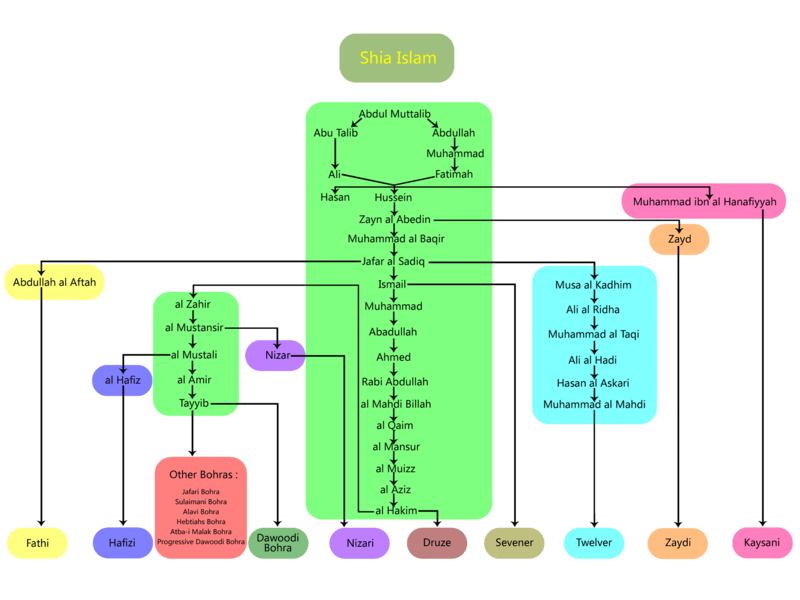Hafizi Isma'ilism
The Hafizi Ismaili or Majidiyyah was a branch of Mustaali Ismailism that believed that the current ruler of the Fatimid Caliphate after the reign of Al-Amir Bi-Ahkamillah, Al-Hafiz was also the Imam of the Time as well as his descendants. The Hafizi sect disappeared completely after the collapse of the Fatimid Caliphate in 567 AH/1171 CE as they joined the Taiyabi sect. The sect was suppressed by the Ayyubid Dynasty that had overthrown the Fatimid Dynasty. The Hafizi sect had followers in Yemen in the form of the Zurayids and the Hamdanids (Yemen). The Hafizi sect lived on into the 14th century CE with adherents in Northern Egypt and Syria but had died out by the 15th century CE. [1]
A further split among the Ismailiyyah still backing the imamate of the Fatimid caliphs occurred after the assassination of Al-Musta'li's son and successor, Al-Amir, by his own vazier, in 1130. Eight months earlier Al-Amir's newborn son, Al-Tayyib, had officially been proclaimed his prospective heir, but a cousin of Al-Amir, Abd Al-Majid Al-Hafiz, was now put on the throne. First merely appointed regent, he was later proclaimed caliph and imam. Some Ismaili communities, especially in the Yemen and India, repudiated his claim and continued to recognize Al-Tayyib, about whose fate nothing is known, as the rightful successor of Al-Amir. They were led by the Sulayhid queen Al-Sayyidah residing in Dhu Jiblah in central Yemen.
Most of the Ismailiyyah in Egypt, southern Syria, and southern Yemen, where they were led by the Zurayid rulers of Aden, accepted the imamate of Al-Hafiz in spite of the irregularity of the succession of a cousin. They were known as the Hafiziyah or Majidiyah. The Fatimid caliphate was now in full decline and was overthrown in 1171 by the Ayyubid Salah Al-Din (Saladin), who restored Sunnism as the official religion in Egypt. Hafizi communities survived chiefly in Upper Egypt and continued to recognize as their imams certain descendants of the last Fatimid caliph, Al-Adid, who were kept prisoners in Cairo. Under official persecution the Hafizi communities gradually disintegrated.
After the overthrow of the Fatimid caliphate in 567/1171 the Hafiziyya, no longer enjoying official support, gradually disintegrated. Al-Adid, the last Fatimid caliph, had appointed his son Da'ud as his successor with the title al-Hamid li'llah. Da'ud was generally recognized by the Hafizis as the imam after al-'Adid. He and all other members of the Fatimid family were permanently detained as prisoners by the Ayyubids.
As a result of a pro-Fatimid conspiracy in Cairo in 568/1172-3 many of the supporters of the deposed dynasty were exiled to Upper Egypt, which became a hotbed of pro-Fatimid activity. There were attempts to restore Fatimid rule in 1174/1175 with the help of Kanz ad-Dawla and Umara ibn Abi al-Hasan al-Yamani. In 572/1176-7 a pretender claiming to be Da'ud found wide support in Qift in northern Egypt. When the real Da'ud died as a prisoner in Cairo in 604/1207-8, the Hafizis asked the Ayyubid al-Malik Al-Adil I for permission to mourn him in public. Al-Adil I granted them permission, but used the occasion to arrest their da'is and confiscate their property.
After Da'ud, his son Sulayman was recognized as the imam. Sulayman died without child as a prisoner in 645/1248 under As-Salih Ayyub, but some of his partisans claimed that he had a son who was hidden (see P. Casanova, Les derniers Fatimides, in MIFAO, vi (1897), 415–45). In 697/1298, a pretender claiming descent as Da'ud bin Sulayman bin Da'ud bin al-ʿĀḍid also attempted to restore Fatimid rule in Egypt with the attempt being defeated by the Mamluk Sultanate (Cairo) under Lajin. Still later, about the year 723/1324, Hafizi Isma'ilis are mentioned in 'Usfun in Upper Egypt and in Syria a Hafizi Isma'ili community is mentioned at the same time in the Baqi'a mountains near Safad.
In the Yemen, the Hafizi Isma'ili cause also lost all official backing with the Ayyubid conquest in 1174. The fall of the Hamdanids (Yemen) and the Zurayids being the two dynasties that supported the Hafizi Isma'ili cause in Yemen. The Taiyabi Da'i al-Mutlaq Ali ibn Muhammad ibn al-Walid (d. 612/1215) composed a polemical treatise and poems against the "Majidiyyah" as they were referred to by the Taiyabi, but they were already becoming a rare minority. The polemical treatise is called Risālat tuḥfat al-murtād wa-ghuṣṣat al-aḍdād, a refutation of the rival Hafizi Isma'ili claims on the imamate, edited by Rudolf Strothmann in Gnosis-Texte der Ismailiten. Arabische Handschrift Ambrosiana H 75, Göttingen 1943, pp. 159–170. The 19th Da'i al Mutlaq Idris Imad al-Din acknowledged that the Hafizi branch no longer existed in his time during the 15th century in northern Yemen.[2]
List of Hafizi Musta'li Ismaili Imams
1. Ali (632-661)
2. Hasan ibn Ali (661–669)
3. Husayn ibn Ali (669–680)
4. Ali ibn Husayn Zayn al-Abidin (680–713)
5. Muhammad al-Baqir (713–733)
6. Ja'far al-Sadiq (733–765)
7. Isma'il ibn Jafar (765–775)
8. Muhammad ibn Isma'il (775–813)
9. Ahmad al-Wafi, died 829, Da'i and "hidden Imam", son of Muhammad ibn Isma'il according to Fatimid Isma'ili tradition
10. Muhammad at-Taqi, died 840, Da'i and "hidden Imam"
11. Abdullah ar-Radi (al-Zaki), died 909, Da'i and "hidden Iman"
12. Abdullah al-Mahdi Billah, died 934, Da'i who openly declared himself as Imam, 1st Fatimid Caliph
13. Al-Qa'im bi-Amr Allah, died 946, 2nd Fatimid Caliph
14. Al-Mansur Billah, died 953, 3rd Fatimid Caliph
15. Al-Mu'izz li-Din Allah, died 975, 4th Fatimid Caliph
16. Abu Mansur Nizar Al-Aziz Billah, died 996, 5th Fatimid Caliph
17. Al-Hakim bi-Amr Allah, 6th Fatimid Caliph, disappeared 1021.
18. Ali az-Zahir, died 1036, 7th Fatimid Caliph
19. Al-Mustansir Billah, died 1094, 8th Fatimid Caliph.
20. Ahmad al-Musta'li Billah, died 1101, 9th Fatimid Caliph, son of Al-Mustansir Billah
21. Al-Amir bi-Ahkam Allah, died 1130, 10th Fatimid Caliph
Al-Hafiz was the son of Abul Qasim Muhammad a son of Al Mustansirbillah and an uncle of Al Musta'alibillah.
22. Abul-Maymun Abdul Majeed Al-Hafiz Li-Dinillah, b. c1076 – d. 1149 CE
23. Abu Mansur Ismail Az-Zafir Bi-Amr-Allah, b. 1133 – d. 1154 CE
24. Abul-Qasim Isa Al-Faiz Bi-Nasr-Allah, b. 1149 – d. 1160 CE
25. Abu Muhammad Abdullah Al-Adid Li-Dinillah bin Yusuf, b. 1151 – 1171 CE, Grandson of Al Hafiz-li-dinillah, Yusuf was the son of Al Hafiz-li-dinillah. Died imprisoned in the Fatimid palace in Cairo under Saladin
26. Daud Al-Hamid-lil-lah, d. 1208 CE (1171–1208). Died in prison under the Ayyubid dynasty.
27. Sulayman Badruddin, d. 1248 CE (1208–1248). Died without issue. Died in prison under the Ayyubid dynasty. The last Imam of the Hafizi Ismailis.
Shia Islam and Hafizi

See also
- List of extinct Shia sects
- Hafizi-Isma'ili family tree
- List of rulers of Egypt
Sources
- Barber, Malcolm (1994). The New Knighthood: A History of the Order of the Temple. Cambridge University Press. ISBN 0-521-42041-5.
- Daftary, Farhad (1998). A Short History of the Ismā'īlīs. Edinburgh: Edinburgh University Press.
- http://www.ismaili.net/Source/0892/postfat.html
- "The Institute of Ismaili Studies" (PDF). Archived from the original (PDF) on 2013-06-22. Retrieved 2014-10-31.
- http://www.ismaili.net/Source/0892/postfat.html
